
Let's go to this interesting interview.

| Due to the weight of this interview, if you want, you can download it to your computer to read it off-line later. Do to that, click in the Edit tab of your browser. Press Select All and after Copy (or press the Ctrl+C keys)). Go to your favorite text editor, open a new document and in the Edit tab, press Paste (or press the Ctrl+V keys). Give a name to your new document and save it to your HD. Presto! You'll be able to read the interview at any time you want. |
 |
During an orchid show in National Park of Itatiaia, at what Francisco Miranda was present as a lecturer and professional orchids grower, we had the opportunity to have a long conversation with him when he talked a little about almost every thing. Know also the work of his wife, Cristina Miranda, a botanical illustrator, in our topic Art Gallery. Let's go to this interesting interview. |
The work with the orchids of the Pão de Açúcar was the 1st study I did, in 1982 or perhaps before. It was a basic study and it was a hard work because we should climb by the rocks to come to the conclusion about how many species occur there. If I remember exactly, we found 12. After that, 2 or 3 species more have been found there, as a matter of fact, we limited our work to rocky areas, to rupicolas orchids, we didn't research the orchids which live in the woods close to Pão de Açúcar.
If I remember exactly, we found 12. After that, 2 or 3 species more have been found there, as a matter of fact, we limited our work to rocky areas, to rupicolas orchids, we didn't research the orchids which live in the woods close to Pão de Açúcar.
Have you still find a lot of Laelia lobata in this habitat?
We have just found only one specimen. Quite a big clump, close to the top but we just saw it blooming one time, after we had finished the work however Pão de Açúcar is not its main habitat. It occurs in almost every rock near the sea, in Rio de Janeiro city. I've already found it in Pedra Bonita, Estrada da Vista Chinesa, in all those stones, you can find Laelia lobata. 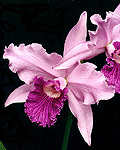
It was very spread in Alto Mourão hill, in Niteroi where, as far as I concerned, it has been rather collected. The distribution center is in Pedra da Gávea (in Rio de Janeiro city), where you can find more, millions of Laelia lobata however the ascent is vertical so the access is difficult. As far as I know, this is a species which is endemic to the state of Rio de Janeiro, restrict to a surface of 30km, from Pedra da Gávea (Rio de Janeiro city) to Alto Mourão hill (Niteroi city).
And the work you have been doing about Laelias?
I have been working in the revision of Brazilian Laelias since 1982, I have been visited the habitats since 15 years ago. Those visits have been just interrupted for a while during the period I lived in Amazon region, from 1983 to 1985.
It is almost finished and I am trying to gather the greatest possible quantity of information about habitats, genetic variations and cultivation. I am trying to do it the most complete as I can. The book is well based and it is interesting that becomes a reference book and has some nomenclatures changes. If someone needs a species description, he can find there.
The expectation created about this book is great, when do you intended to publish it?
The text is almost ready and if I concentrate in the book now, I will finish it in 1 or 2 months.
The first idea was to publish it to the 15th WOC but if it had happened, I haven't included 2 or 3 blooming species I would like to. I have the opportunity to shoot some more species now and some others next year. If I publish it immediately, those photos will wait for the second edition.
Concerning the publisher, I haven't decided yet, I am examining the proposals very carefully.
So this book is a result of a long work of 15 years, will it be the definitive book of the Laelias?
We can say it is a result of 15 years of work although I didn't work full time. I hope it is definitive book until another comes but, as a matter of fact, the habits have been destroyed in a such way that it will be difficult to gather more information than I have been trying to gather along all those years.
During the last 15 years, the destruction of the habitats has suffered an acceleration, hasn't it?
When I visited, in 1982, for example, a mining region, the rupestrian area was intact. In 1985, there was a hole. Now, 12 years later, there should not have even the hole but a cut in the mountain.
And the nomenclature changes you have talked about?
When you do a revision, you should check the types and verify what name should be done to this plant-type. Since the original descriptions, in the works which has been done about Laelias, the types haven't been correctly checked, any mistake, eventually made in those descriptions, has been perpetuated until nowadays. In a revision, you should do the home work which is to check all plants-type. When we did it, we concluded that some species were incorrectly named, so we should correct it. At least, one of those species is very well known.
This change of nomenclature doesn't give any pleasure to me however this work should be really well done and I have already finished it.
When those changes will be done, will they be official? The organizations will recognize this new nomenclature?
The taxonomy is not a exact science, so if I studied Laelia and say something, another research worker also studies and come to another conclusion, if the two results are published, they will be judged, if I can say that, by the botanists who follow them. Depending on the arguments settled, one will be accepted instead of the other.
There is nothing official. Official is the classification of the maintained names. The Taxonomy Committee attends a reunion and maintains certain names which are official proposals from certain peoples. Concerning the names which are not maintained, the opinion accepted is the opinion better based and I am doing my best to base my concepts in order they can't be contested.
Those changes will be done in the book? Which species have you changed the name?
Some of them have been already done in Bradea (Herbarium Bradea bulletin), others will be done in the book which will be well documented with many photos and will have a larger distribution. For example, Laelia flava is not a good name, I won't give the details about the proceedings to change a name because it is already in Bradea and will be in the book, very well explained. Laelia lucasiana isn't either a good name, it is synonym too. Laelia rupestres which changed to Laelia crispata, becomes again rupestres because there was a wrong interpretation of Cymbidium crispatum from where the name was originated. Those are the most known, there are some others and they will be in the book.
There are some problems with others which type doesn't correspond and as the important is the type not what the collectors say...
There are some other plants considered as different species but they haven't been separate and described yet.
Can you say that your work will include all species of Laelia?
In Brazil, yes, I didn't work with the Mexican plants and except for 4 species, I have found all of them in the habitats. I didn't find Laelia fidelensis, for example. Concerning the Laelia rupicolas, I didn't find, in the habitat, Laelia blumenscheinii, Laelia macrobulbosa and also Laelia brevicaulis, a species from Bahia, very close to Laelia harpophylla. Except for those species, I think I've found all of them.
Except for Laelia fidelensis which is a special case, in your opinion, what are the reasons for not found them in the habitats? Would they die out?
No, they are not extinct. If you think about mountain areas, even if you had 10 lives, you wouldn't see every thing. The problem is to know the exact area. Since long time ago, I have been looking for Laelia cardimii and gracilis, every time, someone tells they occur in Serra do Cipó, I've already passed 100m away from the habitat, during the blooming season of Laelia gracilis and didn't find it.
Some Laelias have a more spread distribution, some others, the habitat is more restrict. You must have exact references from where the plant occurs. Some of them, I found by chance, some others, I had a reference of the localization, some others, I should take the collector to show me the place, those which I couldn't find, not even he knew where was the habitat or perhaps the collector wasn't the same who found them.
So there is no registration of those habitats?
Sure there is! There is the localization-type of the plant you study but the collector has it in his memory and says that 10 years ago, he found the plant in a certain place. If, by mischance, you don't find it in that place, you, probably, will not find any where else.
Do they raise difficulties to show the habitats?
Exactly. We must show our habilities to deal with them and also have a good relationship with them. We must explain that we won't gather plants, that we will just take photos, study. It makes things easier.
There are plants which have been found by people who are already dead. To find them, you should have a good luck.
What do you think about Laelia fidelensis' polemic?
The plant exists and the person who found Laelia fidelensis, should bring it from that region but it is a big region. No problems about being a good species and it is certainly Brazilian one because it doesn't occur anywhere else. I am in doubt about coming from São Fidelis but I'll let it to someone else to elucidate. I've tried to find, for three times, I visited places pretended to be its habitat as some people told me but I didn't find it. The localizations were probably wrong.
Which are the main habitats have you visited to do this work?
The seashore woods region, in the South where is the habitat of Laelia purpurata.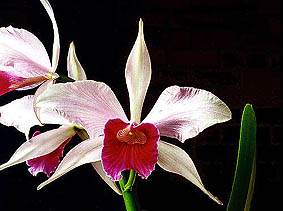
The states of Rio de Janeiro and Espírito Santo where is the habitat of other Laelias with big flowers. We can also find Laelia cinnabarina, in Pedra da Gávea (Rio de Janeiro city), always in out-crop areas where those species occur more frequently.The South of the state of Bahia, habitat of Laelia grandis and mainly the ruprestrian areas which are the habitat of almost all Laelias rupicola in the states of Minas Gerais, Espírito Santo and Bahia.
What can you say about those habitats?
In Rio de Janeiro, the out-crops areas are part of Mantiqueira Mountains, the second mountain range at the sea-shore where the humidity is not high all year round. Those Laelias species like the alternation of drought and humidity periods.
When you get into the country, to Minas Gerais, you pass through Mantiqueira Mountains, where you find just few species, then there is Belo Horizonte city area, going into Serra da Piedade and Serra do Caraça mountain far from 100km, where there is a concentration of iron. When you take the road from Rio de Janeiro to Belo Horizonte, it starts at Serra do Ouro Branco, Congonhas and Serra da Moeda, it means an area of 150 km diameter, in high mountains, at 1000, 1500 , 1700 m above the sea where the most part of those species occur. This central area next to Belo Horizonte, is the center of distribution of the species with rosy-pink flowers, at least 10 of them but it doesn't mean all Laelias have this color. There is Laelia flava which has yellow flowers, Laelia milleri with red flowers but the most part has rosy pink flowers. There is another center of distribution of rupicola Laelias in the outskirts of Diamantina. This is the dispersion center of the species having yellow flowers, there 4 or 5, on the other hand, there also is Laelia rupestres which flowers are purple, Laelia angereri with red-orange flowers.
In the state of Bahia, there is Serra do Sincorá, with long period of drought where there are two species of rupicola Laellia. There also is Laelia sincorana with big flowers which can grow as rupicola or on Vellozia bushes. There, we have basically 3 species so we cannot talk about distribution. There are plants with rose-purple or yellow flowers. To localize this mountain which is found in the center of the state, you have just to do a "X" over the map and it is exactly in the middle of it.
Basically, that is all. Laelia doesn't occur in the north-east neither in Amazon. It doesn't occur in the central region except for Laelia lundii, which grows in Brasilia outskirts, in the woods along the rivers going down to Minas Gerais. To tell the truth, it gets a little into the state of Goiás but it is not a typical species of the region. There are characteristic plants of South and Southeastern region of the country. They all need, as I've already said, an alternation of drought and humidity periods, some ot them grow near to the sea-side, in Atlantic forest, they are more well adapted to year-round moisture. There is no characteristic drought period in Rio Janeiro or Santa Catarina sea-side, for example.
Do the Laelias rupicola need altitude, cold weather and luminosity?
Not necessarily altitude and cold weather but they need luminosity. Look, Laelia cinnabarina occurs in Pedra da Gávea, in Rio de Janeiro city, Laelia gloedeniana occurs at the Espírito Santo coast, from where I took a very interesting photo of a blooming Laelia and you can see the sea 150 m above, it means, close to the sea where the humidity is high. The Laelias rupicolas, in the outskirts Belo Horizonte, live in places a little bit cold, an elevation of 1.100, 1.500m and Laelia kettieana goes to 2000m , in Serra do Caraça which is the most high place of this surroundings. 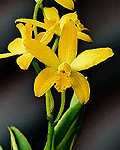 When you take the way to Diamantina, for example,
When you take the way to Diamantina, for example,
Laelia briegeri grows in limited areas, an elevation at about 800m,
where is quite hot, it means, this a plant which needs more hotness.
.
But the nights are cold?
A little cool, they are not that cold. Of course, during the winter, the nights are cold but during the summer, it is almost warm, even at night. The sun is really strong. During the day, this place is extremely hot.
And about the habitat of Laelia purpurata?
It occurs in three states: Santa Catarina, Rio Grande do Sul and São Paulo. It appears in the north of Rio Grande do Sul but doesn't occur until Banhado do Taim. It is abundant at Torres and Osorio region, at the dunes, 100 km far from Porto Alegre. However the main habitat is in the state of Santa Catarina, where it occurs at almost along the seaside. It is plentiful in Santa Catarina Isle.
It doesn't appear in the state of Paraná, for any reason. It could be due to a natural barrier which prevents the seeds dispersion. Perhaps there is no wind during the seeds season, there is a reason but it is still unknown. Than it reappears in São Paulo: Santos, Ubatuba, Caraguatatuba and goes to the north of the state. Although the most near habitat we ever knew is close to the line that divides the states of São Paulo and Rio de Janeiro, it doesn't occur here.
Concerning the preservation of those habitats, what did you find more destroyed?
Belo Horizonte outskirts have been strongly destroyed by the mining industries.
Diamantina surroundings are, more or less, intact, we don't notice a great impact in this region.
So the big predator is the mining, not the collector of the plants?
The mining yes, not the collectors.
Nowadays there isn't so much pressure to take those plants in the nature because the best specimens are usually artificially reproduced. There is no sense to get there and gather 1.000 plants. There are plants which exist thousands and thousands in the habitat, however, some others have a very restrict habitat. Until last year, Laelia milleri was sold, blooming, at the side road, in Belo Horizonte. We found the habitat where it was being collected but this has being destroyed by the minings. Even if it is not collected, the minings will destroy this habitat, the hill is being cut down. 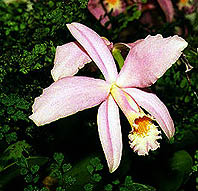 It is difficult to say the plants are disappearing because they are collected. In this specific case, it would be useful but not in the others cases like Laelia jongheana which is taking out from an area which is not threatened, where there is no mining, nothing. According to the information I have, more than 30.000 specimens have been up rooted from the habitat and is illegal taking plants from the nature. I have been there before this and I didn't return yet so I cannot tell nothing about the impact it caused in the habitat. When I have been there, I found a lot of Laelia jongheana. "A lot of" is a subjective concept but when you take off 30.000 plants it is also a lot of and we should verify in what proportion it affects the local population. I'll try to go there next year, during the blooming season because that is the only period we can really find out what left and if we noticed this removal.
It is difficult to say the plants are disappearing because they are collected. In this specific case, it would be useful but not in the others cases like Laelia jongheana which is taking out from an area which is not threatened, where there is no mining, nothing. According to the information I have, more than 30.000 specimens have been up rooted from the habitat and is illegal taking plants from the nature. I have been there before this and I didn't return yet so I cannot tell nothing about the impact it caused in the habitat. When I have been there, I found a lot of Laelia jongheana. "A lot of" is a subjective concept but when you take off 30.000 plants it is also a lot of and we should verify in what proportion it affects the local population. I'll try to go there next year, during the blooming season because that is the only period we can really find out what left and if we noticed this removal.
It is serious because Laelia jongheana is one of the most threatened species. Where is its habitat?
It is funny, many peoples think it only occurs in Pico de Itambé, in the state of Minas, but the localization-type is Caraça. Nowadays, it is not found there, perhaps because people didn't look for it very carefully, it a very extensive area. Until now, it was considered as endemic to a certain place in Minas Gerais but it has been recently found in the state of Espírito Santo, that proves Laelia jongheana has a wider distribution than we thought.
Is there no natural mobility?
Usually, the plants are well adapted to the habitat, there is no mobility, the population is not expanding ou declining, at least, we can not notice that. The most part of the species are well adapted to the local where they live and occur in great quantity, and except for Laelia Cardimii which is rare, difficult to find, even in its habitats in Serra do Cipó. To come back from there and tell you story, you should take care because it is a precipice, if you don't pay attention, you go down straight.
And is Bahia also deforested. Is the cacao cultivation the responsible for this?
The South is a very deforested region but, in fact, the cacao cultivation preserves the forest because the cacao trees need the shade of the woods. For that reason, the owners preserve the big trees to do the shade and when you are far, it seems to be a natural forest, all those big trees, with uncountable epyphitic but the small ones have been changed by the cacao trees. Probably, this is the cultivation which provokes less destruction. On cacao trees, there are Cattleya leopoldii, amethystoglossa. When you get into the country, to dry land woods, they are completely cut down to get the wood. I've shoot that and always show it. There was a great pressure to collect Laelia sincorana in Serra do Sincorá, thousands of it were collected as soon as it was re-found however there still are a lot of specimens. It is a very common plant there.
The great problem there is the fire because it grows in the ground or on the velozzia bushes, a very dry environment and during the winter, the fire is set and burns enormous areas and the plants are lost in enormous quantity too.
What is happening with the habitats of the state of Rio de Janeiro?
The most part of the species live in where we call Atlantic Forest and in the state of Rio de Janeiro, there is at about 6 or 7% of the original forest and we still have this because of the Parati region which is more or less untouched. If you consider from Rio de Janeiro city to the north of the state, you don't have nothing. We just have Velha Joana hill but the South, is more preserved. Laelia crispa occurs there.
We just have Velha Joana hill but the South, is more preserved. Laelia crispa occurs there.
But if we look around Angra de Reis, the situation change. Is there any study about the ecological impact in those surroundings?
The lowlands have been completely devastated to do allotment. All this area with sandy soil was crowded of orchids, Laelia is the least, every thing is being cut down. As far as I know, there is no allotment with a previous study about ecological impact in the environment.
And Espírito Santo?
The vegetable cover of the state of Espírito Santo is reduced to 4% of the original and this destruction is due to the agriculture. Simple territorial occupation. People believe that the big forests occur in rich soil but it is not true, the soil is very poor. After cutting down the woods, the soil is good for 1 or 2 years, then it is finished. So people knock down the wood, use the soil for agriculture during a year or two, then they leave it and go to cut down another one.
The concept is: The forests are endless.
Like happened to Rio and São Paulo during the period of coffee cultivation.
Exactly, you see all this (pointing to Itatiaia National Park) and you can say it is endless but if you start to cut down, treat with carelessness, all those things will be wiped out quickly.
I always remember someone who was a pilot in Amazon and used to say that there was no problem to deforest because he looked to horizon and the only thing he saw was the forest. I always answered that he should fly for 3, 4 hours to have the idea that the forest still exists. If you fly for 10 minutes and get out of the woods, it doesn't exist any more, it is finished.
 Coming back to the state of Espírito Santo, it is very destroyed mainly the central region and it is really a big trouble to Laelia perrinii, Laelia xanthina and some other species of Cattleya like schilleriana.
Coming back to the state of Espírito Santo, it is very destroyed mainly the central region and it is really a big trouble to Laelia perrinii, Laelia xanthina and some other species of Cattleya like schilleriana.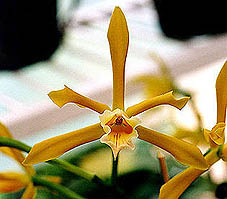 Those species are sufficiently artificially cultivated, I mean the species won't disappear although it can disappear in the habitat.
Those species are sufficiently artificially cultivated, I mean the species won't disappear although it can disappear in the habitat.
However the plant artificially cultivated creates, at long term, a modification, a mutation in the evolution of this species, doesn't it?
When you do an artificial propagation, you are looking for an amelioration in any aspect. Or you are looking for a plant which will give more or better shape flowers. In some years, you will have the species but it will be modified, turn towards what you wanted. To put it other way, the original genetic heritage will be rather modified. Who has the responsibility of maintain, preserve the species as it is, are the botanists, IBAMA, the research institutions. The commercial grower doesn't have the obligation of doing this. He will do it to made a profit on it.
How can we find the responsible for the preservation and ask him to assume an attitude regarding this problem?
No one is responsible for this. The government of the state would say it is the responsibility of local government and they would say it concern the federal government and no one preserves any thing because there is no control. There is a surveillance if you collect a botanical material. You can be put in jail but the lumber merchants keep on felling trees, taking them away and nothing happens.
Your work is, no doubt about, very important. Have you got any financial support from any organism? Or you just put your money to gather all those information? You don't have any specie of subsidy to do this work?
No, therefore the idea of publishing the books to pay part of the expenses but I do this because like do this.
If I was attached to a scientific organism perhaps I would have some facilities to get a financial contribution, I could do projects as I've already seen done which would include travels, publication of reports but with the way I live nowadays, it is impossible to include this kind of work.
I work in my little free times but I have a total flexibility. If I decide to go to Serra do Cipó tomorrow and I have time and if it is priority to me, I will. If I am linked to a project, I should go according to a travel schedule, I should justifies why I want to go there in a specific season of the year and so on. It would be very difficult to me to follow a chronological programme pre-organized. If I receive an allowance or if I do the coordination of a project, I wouldn't have another choice. I could try to get an allowance to do this kind of work but it would take my time flexibility away. 10 years ago, I would be pleasure to do this but nowadays, I just cannot.